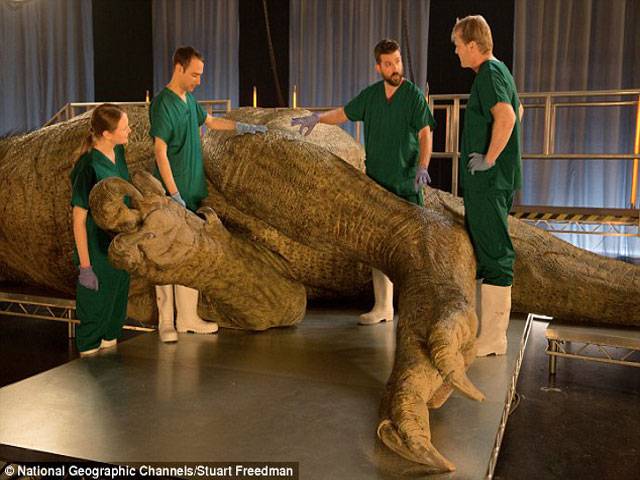MOL
New York
The Tyrannosaurus Rex has baffled scientists for decades, with mystery still surrounding how it could eat with its tiny arms - and even suggestions the predatory dinosaur had feathers.
But experts could finally be on the verge of solving the carnivore’s greatest secrets, after making a life-sized, anatomically complete recreation of the huge dinosaur. In an unprecedented experiment, palaeontologists will dissect the 14-metre long T-Rex in a specially constructed lab in an attempt to fully understand the reptile. The National Geographic Channel’s T. rex Autopsy will see four scientists cut into the world’s first full-size replica of the dinosaur.
The model has eyes the size of grapefruits, teeth which are each a foot long, and a stomach big enough to digest a four-year-old child.
Collaborating with veterinary surgeons, biologists and palaeontologists, the two-hour documentary will show the latest findings about T-Rex.
The scientists hope to use the incredible replica to explore mysteries such as whether the dinosaur was a hunter or a scavenger, how it fed itself with its tiny arms, and whether T-Rex had feathers.
The experts will face the challenge of sawing through the extinct animal’s giant bones, wading through blood and even coping with the overwhelming smell of its innards.
Employing industrial-sized tools, veterinary surgeon Dr Luke Gamble, leads a group of palaeontologists that includes Dr Tori Herridge, Dr Steve Brusatte and Matthew T. Mossbrucker, in cutting the 65million-year-old beast open.
Saturday, April 20, 2024
Dissecting a dinosaur

3:56 PM | March 28, 2024
4:14 PM | March 23, 2024
A Tense Neighbourhood
April 19, 2024
Dubai Underwater
April 19, 2024
X Debate Continues
April 19, 2024
Hepatitis Challenge
April 18, 2024
IMF Predictions
April 18, 2024
Kite tragedy
April 19, 2024
Discipline dilemma
April 19, 2024
Urgent plea
April 19, 2024
Justice denied
April 18, 2024
AI dilemmas unveiled
April 18, 2024
ePaper - Nawaiwaqt
Advertisement
Nawaiwaqt Group | Copyright © 2024





